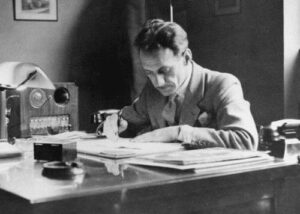
Tannoy Autograph loudspeakersTannoy Autograph loudspeakers
I had the opportunity, to own a rare pair of Tannoy Autograph Loudspeakers. The Tannoys, were located near Vienna in Austria, a good 1000 km away. And, not a decision made between the first and second coffee in the morning. For the first consideration, each speaker is 152cm high, 110 cm wide and 80 cm deep, in a triangle shape, ideally placed into the corners of a room. The Tannoy Autograph is one of the famous horn speakers of the 20th century. And mentioned being in a virtual top ten list but more one of the top five candidates.
On this list, other speakers like the JBL Paragon, the Western Electric WE-type horns, various Horn construction or the Lowther Corner Horn. To make it short, for a Tannoy fan, the Autograph is one of three full-range horn cabinets available. Besides the Westminster, the GRF Professional is the largest initially by Tannoy-made cabinet for recording studios (180cmx120cmx80cm, with two dual concentric drivers in parallel). And almost impossible in home systems.
The Westminster
The Westminster is a rectangular-shaped box similar to the Autograph (as well as rear and front-loaded horn development from the mid 1980ties). These have a very “tasty” cabinet design for the “conservative HI-FI enthusiast wanting the very best”. Available in two different cabinets made from other wooden materials and equipped with modern ferrite magnet chassis or for a reasonable additional charge sold with “limited editions alcomax speakers”. Tannoy Autograph loudspeakers
Design
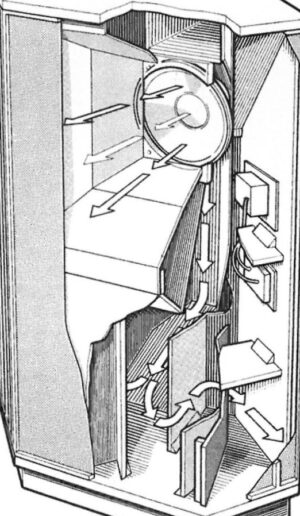
And In addition, due to its more expansive spaces, this design will give a less limited low-frequency response. Also, with a rear horn development of effective 20 Hz to 250 Hz. And a front horn development of effective 250 Hz to 12500 Hz,
The Autograph is one of the rare horn-type speakers capable of transmitting the total audio frequencies. And with all this theory in mind, I had to decide if I would be adventurous and get these two monster-sized speakers. “Who has the corners in a place where the speakers need positioning to work properly?”, “Do I need to get two wardrobes in my living room?”, “If you don’t get these, you never will have a chance to get them again, so you never will know how good they are?” Many questions went through my brain. Tannoy Autograph loudspeakers
I could not decide between being severe or being adventurous. The memory was instantly awake to my GRF Rectangular in 1994. At that time, I was also initially euphoric about the project but later heartbroken to get rid of the relatively large enclosures. If you want to have these prominent speakers, you must have the space and the money. And you should be in a social situation to decide about. I decided I was not. So I left the rare opportunity to my friend, knowing that he would also be very interested in getting a pair of Autographs.
The Adventure
The adventure started already to find a car where these would fit in. With an ordinary estate the minimum size would be a bus or a real transporter. A full-size front-to-front is 1.10x 1.10×1.50m and needs something with a bigger space inside. Packed side to side is 1.50mx0.80mx1.60m and might fit better.
But, we just tied the two speakers together with belts and fastened them on the roof of my partner’s car. Knowing that an overload of 120kg above the allowed 80kg on this car roof will not do any damage within 1000 km of the survey? Ok, we did it without getting into any real trouble. And the final problem was to get these monsters (90 kg each without speaker) into the first floor of the house. Also, where the hifi room is located. And with a bit of help from friends, we managed it.
The Enclosures
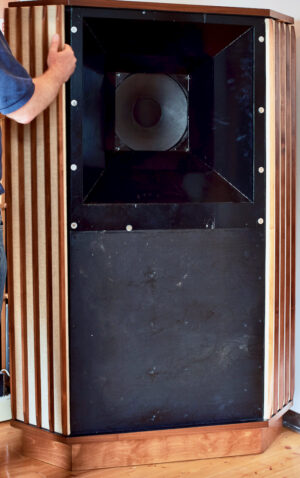
Many vintage speaker plans have been changed to more rigid materials to reduce resonant distortions. In many cases, the overall coherence, often a clear sign of an early experimental design process, gets lost for “improved measurements”. I arranged the first audition for the end of April, and I was very excited to have a first-hand experience with these legends. And drove the car the long way (100 km distance) with speakers in my mind: “will they be that good?”
It is rumoured they will completely disappear in acoustic terms when perfectly matched into a room. Also, known to behave with the fastest and most deep bass response of all Tannoy cabinets. And lots of other excellent attributes, published on the web. I am always more than sceptical about such superlatives, mainly when the rumours are from the web. Who can prove or has a first-hand experience with these rare legends, not to question who knows one person owning a pair?
Listening
The first listening test finished. And the speakers sounded the absolute opposite way of what I expected. The sound very heavy and dark, almost like driven with defective HiFi units. The sound was characterised by a boost of the lower registers. And mainly the frequencies transferred by the back-loaded horn. Also, the cabinets seem to push the frequency between 100 and 200 Hz. And to an extreme, some +6db Tannoy Autograph loudspeakers
This effect entirely dominated the other areas of the tonal spectrum. I really could not believe what I heard. These legendary speakers were so far out of balanced, I could not even remember Tannoy speakers were installed here. However, we did sit for three hours in front of them, listening to different records without having a clear concept to follow for improvements.
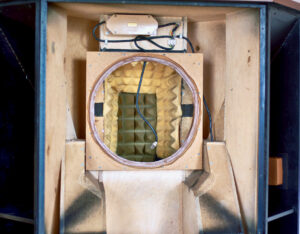
Driving home
Driving back home, I was thinking: what might have been wrong? We had checked all the construction details but found no substantial problem with them. They were made very precisely orientated to the original drawings. We decided to complete the covers as a first step, and later wanted to change the speaker mounting back to the baffle. A new damping material for the compression chamber is in demand as well. Are these systems significantly room dependent because of their corner construction for their position and their physical expanse?
First, one of the Monitor Gold speakers needed an utterly new adjustment of the HF diaphragm with an oscillator. They did not have a smooth HF response. And showed wrongly mounted to the backboard of the funnel. Since this mounting will amplify all the resonances initiated by the speaker.
Hard edge
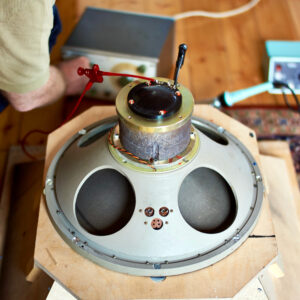
When opened, it could be seen that the last owner had changed the mounting of the speakers. The baffle board is made from different materials and looks very customised, so that it might be introduced later. Initially, the speakers need to get mounted on this square baffle board. This board closes the pressure chamber of the horn against the back of the speaker with a seal. It is entirely damped with acoustic foam. And I am wondering what to do next. Any input would be greatly welcomed and if you have enjoyed reading please share with friends as help is needed! And, if you have enjoyed reading “Tannoy Autograph loudspeakers’, please share with friends and colleagues.
Perkune I Best budget audiophile cables